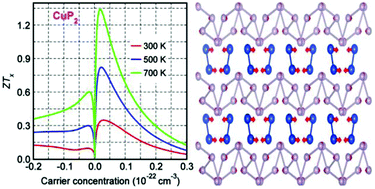Metal phosphide CuP2 as a promising thermoelectric material: an insight from a first-principles study†
Abstract
In the search for better thermoelectric materials, metal phosphides have not been considered to be viable candidates so far, due to their large lattice thermal conductivity. Here we study the thermoelectric properties of metal phosphide CuP2 in the monoclinic phase using first-principles calculations based on self-consistent phonon theory and electron Boltzmann transport theory. Our lattice dynamics calculations reveal that CuP2 exhibits Cu-dimer rattling modes, which strongly scatter the heat-carrying acoustic and low-lying optical phonons, resulting in an unusually low lattice thermal conductivity below 3.6 W m−1 K−1, being about a half of the conventional thermoelectrics GeTe. We predict Seebeck coefficients, the value of which at 300 K is in good accordance with the experiment, and power factors that are superior to the conventional thermoelectrics GeTe, possibly due to flat- and dispersive-band structures with high orbital degeneracy. Finally, we assess its thermoelectric performance by evaluating the figure of merit ZT, finding that upon p-type doping ZT can reach over 1.3 at a high temperature of 700 K by optimizing the hole concentration. Our results highlight the potential of using metal phosphide CuP2 as a promising material for thermoelectric applications with practical performance and low cost.



 Please wait while we load your content...
Please wait while we load your content...